How The Pandemic Is Making It Even Harder For Food Banks To Survive
There's one time of year when food banks usually begin to struggle the most, according to Real Simple: April, when the holidays are over and donations typically start to plummet. Unfortunately, as The Guardian reports, food banks are now facing hardship year round due to COVID-19. With the omicron variant on the rise, it's becoming increasingly difficult for food banks to stay up and running, or even recover, from 2020.
Non-profit organization Feeding America explains that demand at food banks has more than doubled because of the pandemic. Due to the growing number of job losses and business closures, the amount of people facing food insecurity has gone up by 55%, and during 2020, four in 10 people turned to food banks for the first time. That year, food banks "distributed 6 billion meals" across the U.S., but Feeding America shares that number was expected to reach 6.5 billion in 2021. But the reason food banks are facing so much difficulty is not to blame on demand and decreased donations alone.
Food banks are heavily affected by inflation and the supply chain crisis
Because food banks rely on donations and volunteers, the current inflation rate and the supply chain crisis are jeopardizing their ability to stay open, and that's all on top of the pandemic, CNBC reported in late 2021. The price of food has gone up by an average of 5%, and meat — one of the most requested items – is in short supply. Ground beef now costs 25% more in some states, and such an increase discourages people from donating it to food banks.
At the same time, the supply chain crisis is affecting day-to-day operations at food banks. Driver shortages bring challenges to transportation, which means picking up and delivering food takes longer than usual. The Guardian adds that the supply chain crisis has also caused box shortages: usually food is organized and sorted into boxes (the Alabama food bank coordinator The Guardian spoke with shared their boxes are "designed to feed a family of four for a week"), but without the boxes being delivered on time, volunteers are held up from doing their job and people are prevented from getting their food.
Despite these obstacles, food banks say they're doing their best to continue serving their communities while they depend on the generosity of donors and hope deliveries show up on schedule.

